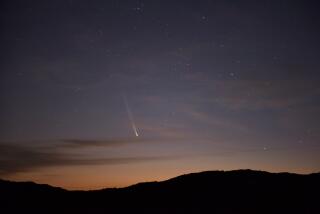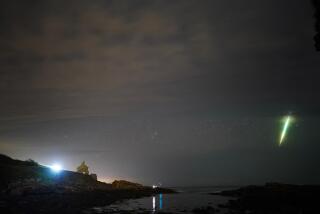A naked-eye comet, visible in the New Year’s Eve sky
This New Year’s Eve, a fuzzy green comet named Lovejoy will be just barely visible to the naked eye in the vicinity of the constellation Orion’s feet.
If you know exactly where to look, you may be able to spot it.
But if your New Year’s plans do not involve standing in the cold and staring at the sky, don’t worry. Astronomers expect Comet Lovejoy to grow brighter in the coming weeks from its current magnitude of 5 to a magnitude of 4.1.
Wednesday night the best time to see the comet is 11 p.m. local time, and if you have a small telescope or a pair of binoculars, you will want to use it. Sky and Telescope magazine’s senior editor, Alan MacRobert, reported that he was able to see the comet on Tuesday using 10x50 binoculars, even in the light-polluted skies of suburban Massachusetts.
Comet Lovejoy is the fifth comet discovered by and named for the amateur Australian astronomer Terry Lovejoy. The green color comes from diatomic carbon (C2) that is coming off its nucleus. C2 glows green in the near-vacuum of space.
The comet is currently on a very long orbital path of about 11,500 years. MacRobert reports that this is not the first time it has flown through the inner solar system.
Astronomers also expect that its orbit will be slightly altered in the future, so it’s next visit will be only 8,000 years from now.
Happy sky watching and Happy New Year!
P.S. For great pictures of the comet, check out SpaceWeather.com, and SkyandTelescope.com.
Science rules! Follow me @DeborahNetburn and “like” Los Angeles Times Science & Health on Facebook.







